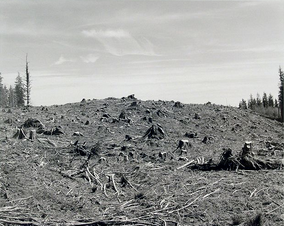
![]() A forest is felled, with stumps and roots and nature’s rubble littering the ground. A few distant trees stand like parentheses on the edges, as the hill rises to meet the sky. A deep sense of loss pervades the image, as we confront the aftermath of industrial forestry in Clatsop County, Oregon.
A forest is felled, with stumps and roots and nature’s rubble littering the ground. A few distant trees stand like parentheses on the edges, as the hill rises to meet the sky. A deep sense of loss pervades the image, as we confront the aftermath of industrial forestry in Clatsop County, Oregon.
In 2006, through a generous gift, the Middlebury College Museum of Art acquired a complete set of Robert Adams’ photographic essay, Turning Back, A Photographic Journal of Re-Exploration, comprising 164 photographs on the theme of deforestation. In response to the bicentennial of the Lewis and Clark expedition, Adams turned back from the Pacific Ocean and photographed what is left of the vast forest the explorers encountered two centuries earlier.
Such are the ravages of clear cut logging. As new trees fill in, they are the same age, and the forest’s ancient markers of time are eradicated. Trees no longer hold water, nutrients are leached from eroded soil, and undergrowth and habitats are destroyed. Given the current rate of deforestation, the world’s rainforests could disappear completely in a hundred years.
Prior to the arrival of European-Americans, about half of the United States was forest. Adams observes, “The importance of what’s going on in terms of clear-cutting is that there is no indication that this can go on forever. If you turn the globe, you see a history of deforestation that changed societies and from which there has not been, in many cases, a complete recovery—in some cases, no recovery at all. The nub of it is that if you keep cutting (and bear in mind that the cutting now is sustained by the use of artificial herbicides and fertilizers), the soil is eroded more and more. It’s a major contributor to global warming.”[footnote]Interview with Robert Adams: “Turning Back,” Art 21 online magazine. http://www.art21.org/texts/robert-adams/interview-robert-adams-turning-back, accessed January 4, 2017.[/footnote]
Adams situates clear cutting within larger social and political contexts, ironically noting that taxes from industrial forestry are used fund schools and, the argument goes, benefit children. Adams counters, “I think it’s also a terrible example of violence and heedlessness to offer to each new generation. If you don’t care about what your grandchildren and their children are going to inherit, what do you care about?”[footnote]Interview with Robert Adams: “Turning Back,” Art 21 online magazine. http://www.art21.org/texts/robert-adams/interview-robert-adams-turning-back, accessed January 4, 2017.[/footnote]
Listen as professor of Biology and Environmental Studies, Steve Trombulak, discusses the pros and cons of clear cutting. And scroll down to hear Middlebury student Tevan Goldberg interpret the photograph with music:
https://vimeo.com/223285310